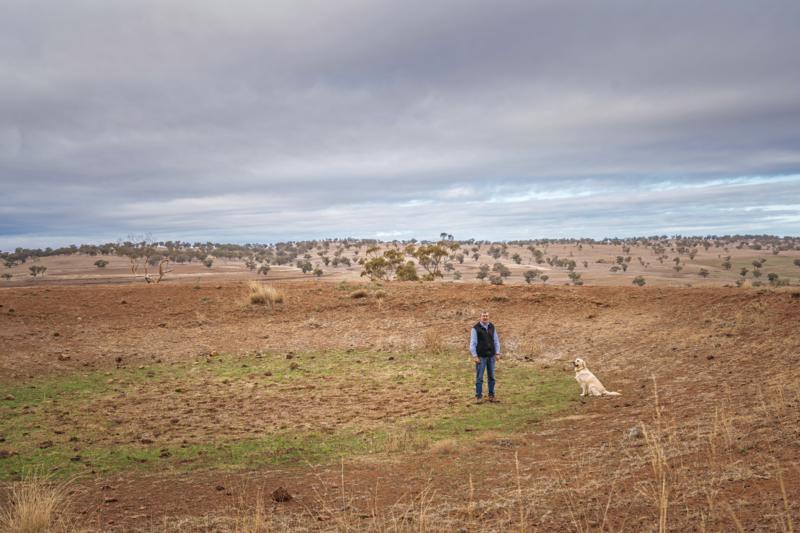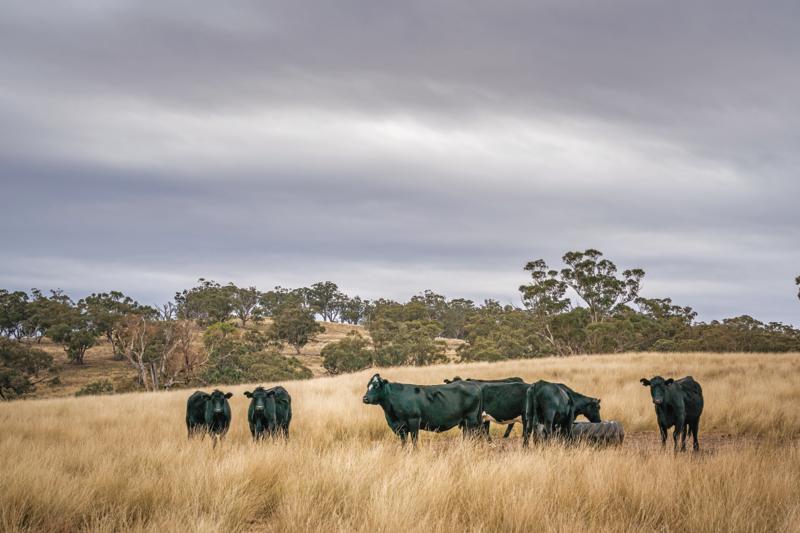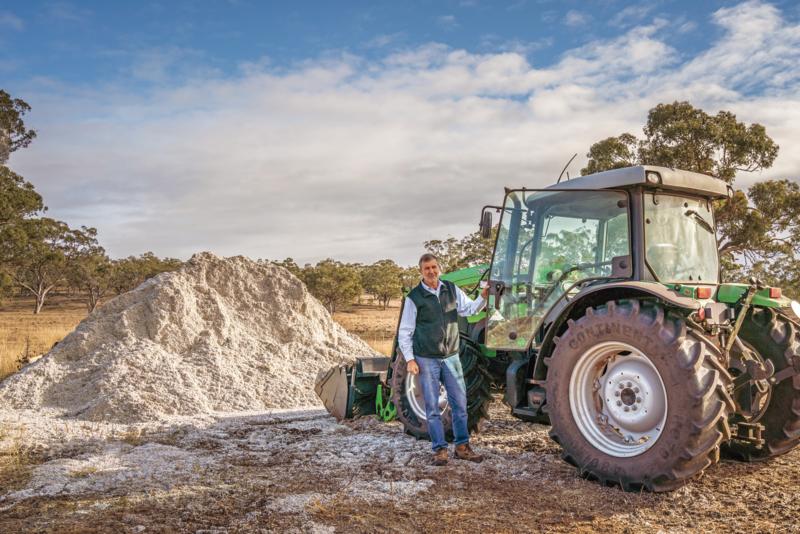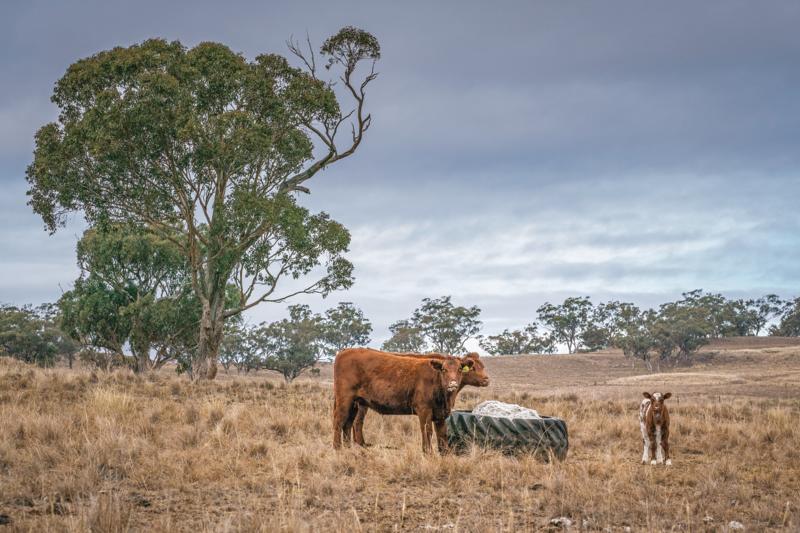DECIDING what to do with your livestock in a dry period or drought is a difficult decision and one that isn’t made lightly. Do you feed them, sell them, put them on agistment or not join them? It all comes down to individual circumstances and choosing the best options to ensure you are economically and environmentally sustainable into the future.
One of the hardest things about drought conditions for Australian farmers is they can never tell when they will end, making the choices that have to be made even harder. However, the overwhelming advice and feedback from those in the industry is that making a plan for when drought eventuates is the best course of action.
It’s something cattle producer Tony Hegarty knows all too well. A member of NSW Farmers’ Cattle Committee and vice-president on the
Cattle Council of Australia board, Tony runs a 1,000-hectare property called Belvedere at Cassilis in the NSW Hunter region with his wife Jane. For the third time since they took on the property in the mid-1990s, they have decided to proactively de-stock.
 Tony and Gracie in a dried-out dam. He is now relying on water from bores to keep water troughs filled.
THE THREE-PART PROCESS OF DESTOCKING
Tony and Gracie in a dried-out dam. He is now relying on water from bores to keep water troughs filled.
THE THREE-PART PROCESS OF DESTOCKING
Tony says there are three parts to the decision-making process for them. “It’s the economics of how long you feed for. As the dry period goes on the price of feed goes up and once you are locked in to feeding, you have no control over the price and the length of time you are going to do it,” he says.
The second part to the decision, Tony says, is the environmental component, as you have to consider the impact on your pastures and water, and ensure you look after the landscape. “The third part is our personal stress levels,” he says. “The process of selling the breeding herd is stressful, however the impacts of drought on environment, animals, financials and people is, in my mind, greater.”
The first time the Hegartys de-stocked was in 2007 and they had to do it “fairly quickly”, selling all their sheep in just four days when they lost water from the creek and bore on a block they leased. After this phase, they bought back in all cattle, instead of sheep.
The second time they de-stocked completely was in December 2012 and they chose agistment because it was available. However, Tony says, freighting cattle down to Braidwood in the South East and Wallendbeen in the Riverina was “rather expensive”.
This time around, Tony says they started de-stocking their entire herd by selling them off from March 2017. “It was obvious we wouldn’t be able to finish the cattle we wanted to, so we started by selling the steers, then the cull heifers and then, as things deteriorated, we sold the replacement heifers, followed by the cows and calves and finished in October. We did not consider agistment would be reliable this time.”
 Some of the cattle bought after the November and February rains.
Some of the cattle bought after the November and February rains.
They then had a little bit of rain in November, so they purchased some cattle in December, and after a bit more rain in February, they bought in some sheep and more cattle. “Those rainfall events didn’t give us a bumper season, but there is some dry feed and we are supplementary feeding the cattle with cottonseed and the sheep with lupins,” Tony says. “We looked at the purchase price of the sheep and the opportunity for Merinos and wool is good, so when we went through the figures it made sense to buy in sheep.”
 Tony is supplementary feeding the cattle with cottonseed to increase the protein level for the pregnant and lactating heifers.
Tony is supplementary feeding the cattle with cottonseed to increase the protein level for the pregnant and lactating heifers.
When working out their stocking rate, Tony says he works on a dry sheep equivalent (DSE) based on rainfall. While the average annual rainfall for Belvedere is 620mm, they’ve only had about 310mm for the 12 months to June this year. “At 620mm of rain we work on 7.4DSE per hectare, but this is down to around 2.2DSE per hectare.”
MAKING PLANS BASED ON PASTURE AVAILABILITY AND RAINFALL
For Tony, a whole series of questions goes into forming a plan about what to do with livestock during a dry period. He says it is important to be able to define what a dry season is and what a drought is, looking at rainfall and the amount of feed available.
“We can look ahead and if there was no rain for three months, what would it look like and what order would you sell and when,” Tony says, adding that de-stocking in drought has nothing to do with the market, it’s based on the feed they have. Being sustainable and looking after the pasture is important.
 The fence line between a recently grazed and a de-stocked paddock at Belvedere.
The fence line between a recently grazed and a de-stocked paddock at Belvedere.
Belvedere is made up of heavy basalt soils and hill country. “If it gets too bare, we lose soil when we have high intensity rain, so we want to maintain some ground cover,” Tony says. Grass also responds quicker when the season does break if livestock hasn’t battered the pasture.
When talking about droughts and dry seasons, Tony says resilience is important and while it can be emotional making hard decisions, it has to be based on business and economics.
“The main adaptability has to be in management and for that reason we opted in to some sheep this time,” he says. “We are managing the dry season now, but the decisions we make impact on the future sustainability of the business and landscape – and the people.”
For farmers dealing with drought or dry conditions, Geoff Casburn, sheep development officer for the
NSW Department of Primary Industries in Wagga Wagga, says individuals need to assess their personal situation. He says de-stocking, partially or fully, is a decision often best made early and progressively.
“Longer periods of drought tend to favour de-stocking, but the downside is, no-one knows how long a dry or drought period will last,” Geoff says.
*NSW is brimming with innovative farmers who are adapting their practices to deal with dry conditions. Read about the young welder who is recycling shipping containers to build sheep feeders to cope with drought: ‘Young gun farmer creates drought lifesavers’.
Currently, Geoff thinks most sheep producers will be feeding sheep, especially in the mixed farming areas, while cattle producers would have partially de-stocked, or would be considering it. “De-stocking partially or fully requires careful consideration as it will impact on future years’ production and income.”
He says de-stocking allows paddocks to recover quickly and may allow early buyback when demand and prices are lower. “Income during the drought from the sale of wool and progeny will be lost and also needs to be accounted for,” Geoff says.
 Tony’s new heifers began calving (as of early July).
Tony’s new heifers began calving (as of early July).
However, de-stocking isn’t for everyone, as it can affect genetics and production in the future. Brett Littler, senior land services officer (livestock) for the Central Tablelands Local Land Services in Mudgee, says during dry periods farmers need to protect their pastures. It’s important to “lock up” pastures to avoid livestock damaging them when there is nothing left to eat, he says. “You have to have a plan and stick to it.”
*Read about the Central West wool and lamb producers, Wayne and Lynette Culverson who are staying positive and supporting one another through the tough times.
WHERE TO GET HELP AND SUPPORT
A clever interactive online tool can show you the exact conditions in your area. For the first time, this is at the touch of a computer key. The NSW Department of Primary Industries (DPI)
Combined Drought Indicator allows you to click on your region and zoom into your parish.
The DPI’s online
DroughtHub provides all the information you’ll need on government help and advice. It has a range of calculators, including an Excel spreadsheet that helps producers make decisions on salvaging crops during drought. This allows you to key in all your own figures, so you can calculate the cost of baling crops for hay or silage, and the price of taking the crops through to harvest.